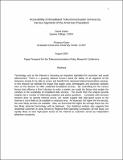| dc.description.abstract | Technology such as the Internet is becoming an important ingredient for economic and social
advancement. There is a growing national concern about the ability of all segments of the
American society to be able to access and benefit from advanced telecommunications services.
In this research we estimate the impact that supply costs, demographic and economic variables
have on the decision to offer residential broadband services. By controlling for the various
factors that influence a firm?s decision to enter a market, we model the factors that explain the
variation in the availability of broadband data services. The results from this analysis provide
insights into a number of interesting academic and policy questions. Consistent with previous
research done on general Internet access, our results suggest that high-speed access to the
Internet is more likely to be available in urbanized area. As expected, the higher the line density,
the more likely services are available. Also, we found that the higher the average fixed cost, the
less likely advanced technology will be deployed. Our statistical analysis also suggests that
residential customers in areas served by Regional Bell Operating Companies, all else equal, are
equally likely to have high-speed access to the Internet as customers served by Independent
telephone companies. | en |
